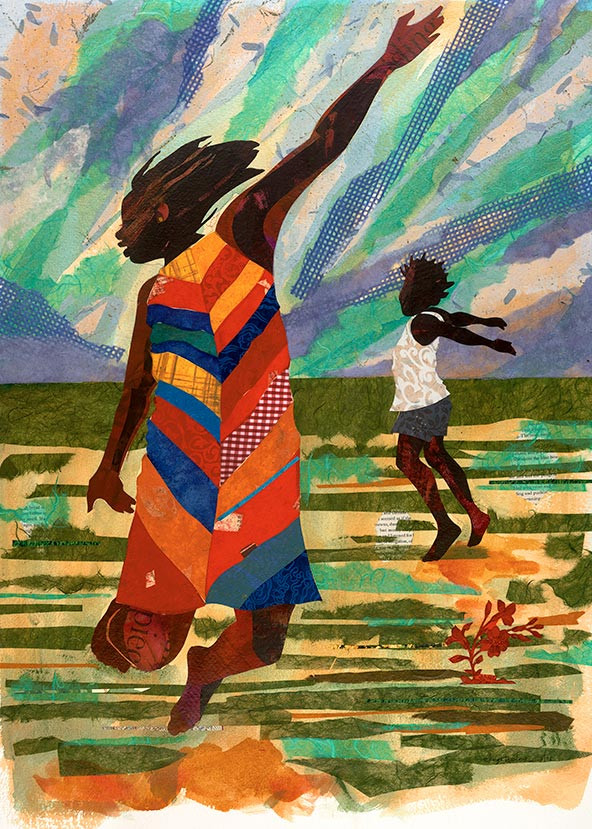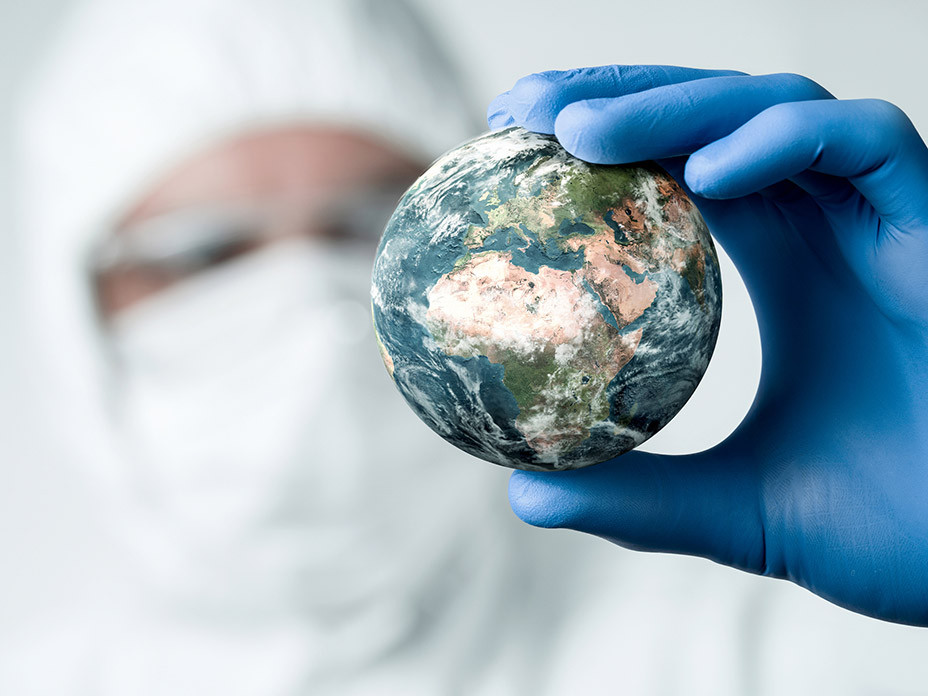 (Free to Be collage by Ekua Holmes/www.ekuaholmes.com)
(Free to Be collage by Ekua Holmes/www.ekuaholmes.com)
With the highest incarceration rate in the world, US prisons and jails are drivers for the catastrophic outbreak of COVID-19. Because of dense living conditions, limited soap and hand sanitizer, poor access to quality healthcare, and an increasingly elderly population, the outbreaks we’ve seen so far may be just the beginning.
It’s no surprise that hundreds of municipalities are already working to meet the crisis by reducing prison populations, whether by identifying those incarcerated for misdemeanors, near the end of their sentences, or with special risk (pregnant inmates, those over the age of 60, or with underlying medical conditions). But as exciting as these efforts are, this moment requires that we imagine something more than a temporary solution to this pandemic. Without a long-term plan for true decarceration, at a larger scale, and the necessary infrastructure to support both returning citizens and their communities, we will inevitably backslide and refill these institutions. We need visionary solutions crafted in collaboration with the communities most impacted.

A Crisis of Imagination
Our world has largely been designed by the powerful, the overwhelmingly white, wealthy, able-bodied, cisgender men who have, historically, decided what is “best” for the masses (while knowing very little about them). Without investing in fostering a new collective imagination, informed by diverse perspectives, we are doomed to perpetuate the same racial disparities.
Calling imagination “a contested space,” Princeton professor Dr. Ruha Benjamin argues that building an equitable world requires that we first “acknowledge that most people are forced to live inside someone else's imagination.” And in the past weeks, we’ve arrived at yet another moment of reckoning, as the murders of Breonna Taylor, Tony McDade, Ahmaud Arbery, and George Floyd have awoken many to the nightmare that black communities have lived in since the founding of this country and led many to protest demanding change. The horrific stories of these murders have extended the need for our society to not only build a system to replace incarceration but to fully reimagine the function of police. Like the prison system, the police force operates as it was intended to: targeting low-income and communities of color and projecting a narrative of “order and control,” a narrative which requires communities of color to abide by rules created by the descendants of the white looters that murdered and stole land and labor from Indigenous and Black communities to build what we now know as the United States. The everyday consequence for defying this contradictory system has always proven to be deadly.
These inequities can also be found in what has and has not been built in our neighborhoods, cities, and communities: freeways that have historically erased black and brown communities, towers to house the elite, and prisons and jails that act as a modern form of slavery, while black and brown communities are denied the adequate housing, parks and open spaces, public transportation, and accessible medical and social services they need to thrive. Architecture that lasts for generations makes it hard to imagine different possibilities, which a crisis like the pandemic only exacerbates, particularly for communities left reeling from generations of inequities
How do we respond to the crisis without returning to the status quo? What might be possible if we invested the $100 billion spent a year on policing and the $80 billion dollars we spend on prisons, instead, in addressing the un-resourced cultural, economic, education, public health, housing, transportation, climate/environmental, and other basic human needs that lead everyday humans to making choices (considered illegal) just to survive and keep food on the table? We believe that to build a more equitable world, we need to create spaces for radical imagination. We need to invest in infrastructure that gives the agency to those most impacted by injustice to engage their creative powers in redesigning these destructive systems.
Building a Vision for Justice
A first step is to look to those who understood that we can remake the world—“solutionaries” like Audre Lorde, Octavia Butler, and Grace Lee Boggs, and groups like the Black Panthers and the Young Lords—leaders who worked to cultivate an imaginative space that could deconstruct racism, and to build more equitable systems to make the old ones obsolete. When the Black Panthers recognized that people of color were going hungry, impacting young people’s ability to learn, they created The Black Panthers' Free Breakfast for School Children Program which fed tens of thousands of hungry kids and later became a part of school infrastructure across the country.
The work of pioneers in scientific research on creativity such as Mark Runco and the late Dr E. Paul Torrance also provide a road map to radical visioning, showing how creative practices such as art-making have been connected to the development of this rich imagination or what is known as elastic thinking. “I don't know what the next American revolution is going to be like,” as Grace Lee Boggs knew intuitively, “but we might be able to imagine it if your imagination were rich enough.” And, today, we are experiencing a renaissance in our understanding of the role that creative practice plays in opening minds and a growing number of designers and artists are harnessing the power of cultural practices to engage communities in radically reimagining a new set of social systems.
Designing Justice + Designing Spaces (DJDS), for example, is an architecture and real estate development firm that is part of this movement, revealing what it looks like when communities of color are given the agency to engage their creative powers in redesigning destructive systems and building their own just ones. For example, the Atlanta City Detention Center (ACDC) has been transformed into a center for equity and wellness. DJDS designed a community engagement process that helped local residents provide input on how the former jail could be repurposed to benefit the community and address its harmful effects. During a series of town halls, residents used board games, building blocks, models, dice, poker chips, and other innovative tools to spark a dialogue among a diverse group of community members that included the formerly incarcerated and people without homes, while educating participants in the basics of design, financing, and real estate development. At a typical workshop, people who arrive closed off, stressed out, and irritated become open and joyful within thirty minutes, unleashing an incredible flow of ideas and creativity. This creative and liberating process—which is being developed for virtual implementation during COVID-19—serves as a model for other cities as the move to decarceration leads to closures of detention facilities nationwide.
Other pioneers in this movement include The Design Studio for Social Innovation, which has partnered with community members, activists, and artists to create pop-up Social Emergency Response Centers in communities across the country, addressing various emergencies ranging from police brutality to immigration raids and economic displacement. Through art, food, and critical dialogue, these Social Emergency Response Centers provide the space and tools necessary for communities most impacted by injustice to begin not only healing but also designing and building solutions.
Another example is transmedia artist Stephanie Dinkins, who has created a series of workshops called AI.Assembly to bring diverse participants together to brainstorm solutions to injustices tied to artificial intelligence. These systems, which use artificial intelligence to identify people based on their facial characteristics, are up to 100 times more likely to misidentify Black and Asian people than white men, which can result in making people of color more vulnerable to data hacks and misidentification in police investigations.
Conclusion
We believe that COVID-19 has amplified the desperate need for our systems to be radically reimagined.
A beginner’s roadmap for those of us in positions of power and privilege:
- Question any impulse that prioritizes efficiency or profit at the expense of human life.
- Recognize and accommodate the costs of participation for community members, including things like childcare, elder care, meals, transportation, and accessible interpretation services.
- Compensate people for their time and intellectual and cultural capital. Remember that if a low-income resident is given a choice between attending an unpaid feedback session on a development project or going to the minimum-wage job they rely on to survive, they have no choice but to go to work. A simple solution would be to allocate resources that compensate community members for their intellectual contributions in the same way we compensate engineers for their expertise.
So, let’s get to it! No matter where you sit, you have the capacity to contribute to change and the growth of imagination that will inevitably lead us to a dismantling of our unjust criminal justice system and more.
Support SSIR’s coverage of cross-sector solutions to global challenges.
Help us further the reach of innovative ideas. Donate today.
Read more stories by Deanna Van Buren & F. Javier Torres-Campos.

